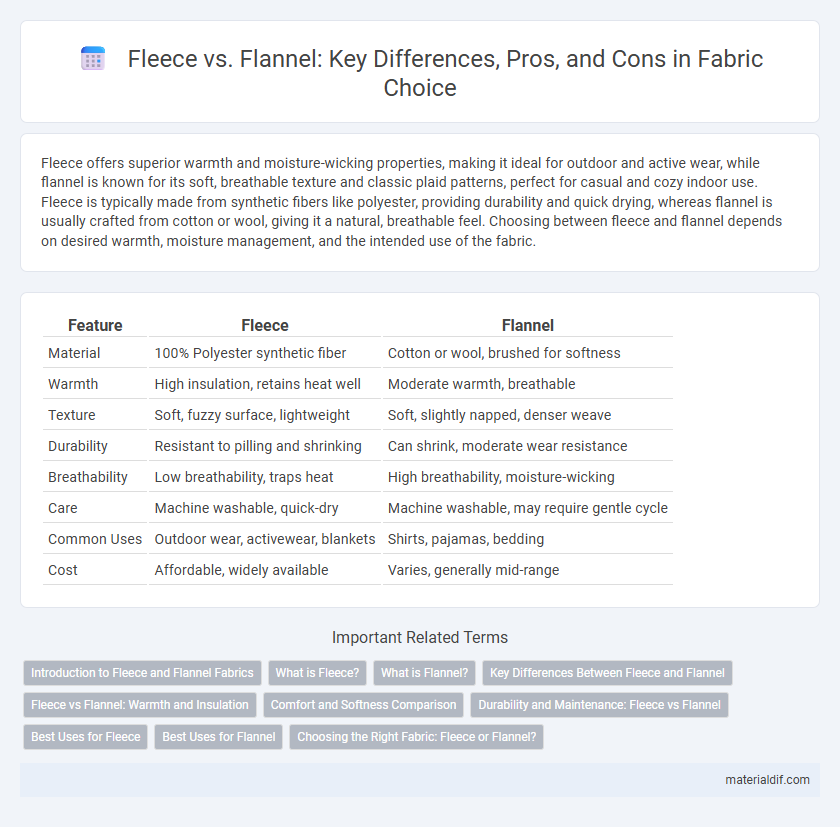Fleece offers superior warmth and moisture-wicking properties, making it ideal for outdoor and active wear, while flannel is known for its soft, breathable texture and classic plaid patterns, perfect for casual and cozy indoor use. Fleece is typically made from synthetic fibers like polyester, providing durability and quick drying, whereas flannel is usually crafted from cotton or wool, giving it a natural, breathable feel. Choosing between fleece and flannel depends on desired warmth, moisture management, and the intended use of the fabric.
Table of Comparison
| Feature | Fleece | Flannel |
|---|---|---|
| Material | 100% Polyester synthetic fiber | Cotton or wool, brushed for softness |
| Warmth | High insulation, retains heat well | Moderate warmth, breathable |
| Texture | Soft, fuzzy surface, lightweight | Soft, slightly napped, denser weave |
| Durability | Resistant to pilling and shrinking | Can shrink, moderate wear resistance |
| Breathability | Low breathability, traps heat | High breathability, moisture-wicking |
| Care | Machine washable, quick-dry | Machine washable, may require gentle cycle |
| Common Uses | Outdoor wear, activewear, blankets | Shirts, pajamas, bedding |
| Cost | Affordable, widely available | Varies, generally mid-range |
Introduction to Fleece and Flannel Fabrics
Fleece fabric, made from synthetic fibers like polyester, is known for its lightweight warmth and moisture-wicking properties, making it ideal for outdoor and activewear. Flannel, typically crafted from cotton or wool, offers a soft, brushed texture that provides natural insulation and breathability, often favored for cozy, casual clothing and bedding. Both fabrics are valued for their comfort and thermal qualities but differ significantly in fiber composition and moisture management.
What is Fleece?
Fleece is a synthetic fabric made primarily from polyester fibers, renowned for its lightweight yet insulating properties. It is engineered through a knitting process that creates a soft, fuzzy texture, providing excellent warmth retention and moisture-wicking capabilities. Often used in outdoor clothing and blankets, fleece offers durability, quick drying, and breathability, setting it apart from natural fabrics like flannel.
What is Flannel?
Flannel is a soft, woven fabric typically made from cotton, wool, or synthetic fibers, known for its brushed surface that enhances warmth and comfort. Its dense weave and fuzzy texture make it ideal for cold weather clothing, bedding, and casual wear. Flannel's moisture-wicking properties and breathability distinguish it from other fabrics like fleece.
Key Differences Between Fleece and Flannel
Fleece is a synthetic fabric made primarily from polyester, known for its lightweight warmth, moisture-wicking properties, and quick-drying ability, making it ideal for activewear and outdoor gear. Flannel is a woven fabric usually made from cotton, wool, or a blend, recognized for its soft, brushed texture, breathability, and insulating qualities suited for cozy clothing and bedding. The key differences lie in their material composition, moisture management, and thermal performance, where fleece excels in synthetic warmth and durability, while flannel offers natural softness and breathability.
Fleece vs Flannel: Warmth and Insulation
Fleece, made from synthetic fibers like polyester, offers superior warmth and insulation due to its ability to trap heat while remaining lightweight and moisture-wicking. Flannel, typically crafted from cotton or wool, provides natural breathability and moderate warmth but tends to absorb moisture, which can reduce its insulating effectiveness. For optimal cold-weather performance, fleece excels in retaining heat during damp conditions, whereas flannel is preferable for dry, mild climates requiring cozy softness.
Comfort and Softness Comparison
Fleece offers superior warmth and softness due to its synthetic fibers that trap heat and feel plush against the skin, making it ideal for cold weather. Flannel, made from cotton or wool, provides a soft, breathable texture with a cozy feel but is generally lighter and less insulating than fleece. Comfort preferences depend on the desired warmth and fabric breathability, with fleece excelling in insulation and flannel favored for gentle softness and moisture-wicking properties.
Durability and Maintenance: Fleece vs Flannel
Fleece fabric offers superior durability due to its synthetic fibers, resisting pilling and maintaining shape after multiple washes. Flannel, made from cotton or wool, requires gentler care to prevent shrinking and wear, often needing cold water and low heat drying. While fleece demands less maintenance overall, flannel provides a softer feel but may show signs of wear more quickly.
Best Uses for Fleece
Fleece fabric excels in warmth and moisture-wicking properties, making it ideal for activewear, outdoor clothing, and cold-weather layers. Its lightweight and breathable nature provides comfort during physical activities, while retaining heat effectively. Fleece is also commonly used for blankets, hoodies, and jackets due to its quick-drying and insulating capabilities.
Best Uses for Flannel
Flannel fabric is best suited for cozy clothing like pajamas, shirts, and bedding due to its soft, warm, and breathable texture, making it ideal for cool weather. Its brushed surface enhances insulation while maintaining comfort, perfect for casual wear and home textiles. Flannel's durability and moisture-wicking properties also make it a top choice for outdoor layering and cold-weather activities.
Choosing the Right Fabric: Fleece or Flannel?
Fleece offers superior warmth and moisture-wicking properties, making it ideal for outdoor activities and cold, damp environments. Flannel provides a soft, breathable, and lightweight option, perfect for casual wear and layering in moderate temperatures. Selecting between fleece and flannel depends on the desired balance of insulation, breathability, and fabric weight for specific comfort needs.
Fleece vs Flannel Infographic

 materialdif.com
materialdif.com